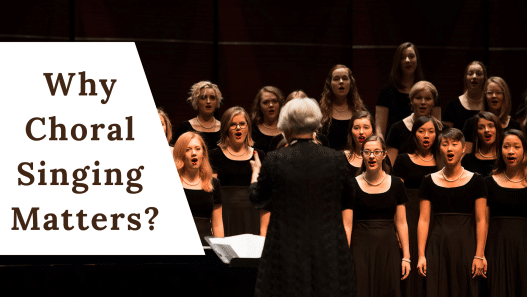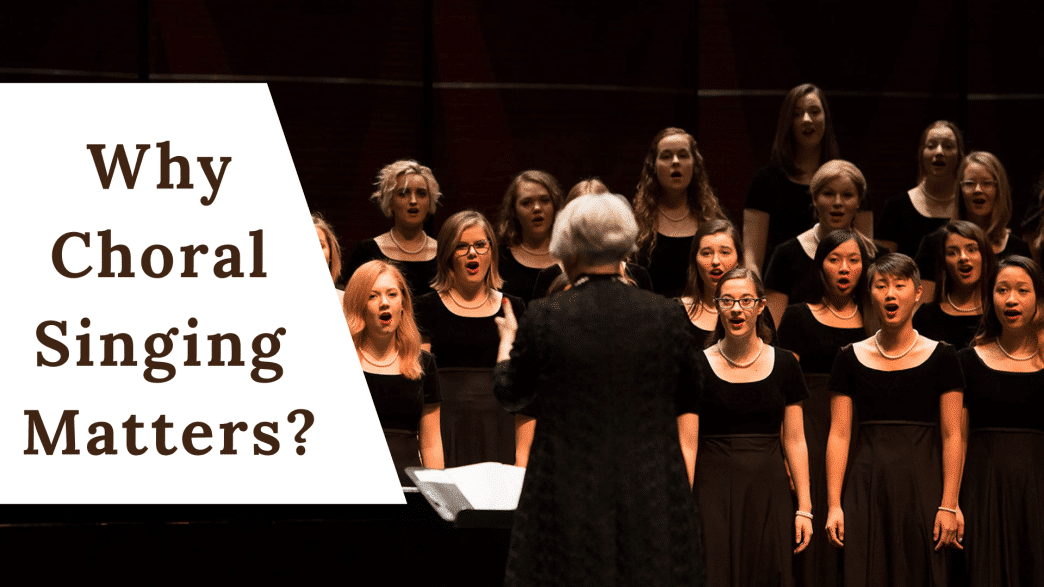Ever wondered why people feel lighter after singing together? Or how a simple blend of voices can stir emotions, calm nerves, and even improve your health?
Choral singing isn’t just about hitting the right notes – it’s a world of hidden benefits waiting to be uncovered.
From ancient chapels to modern classrooms, this age-old tradition has quietly transformed minds, bodies, and entire communities. But what’s really happening behind the scenes (and vocal cords)?
Why are researchers, teachers, and therapists all tuning in to this harmonious practice? In the paragraphs ahead, we’re peeling back the curtain on the magic of group singing. Spoiler: it’s not just about music.
Get ready to dig into secrets your lungs, brain, and soul have been humming about all along. Let’s dive into the symphony within!
What is Choral Singing?
Choral singing is simply a group of people singing together as one voice. Unlike singing alone, choral singing involves multiple voices working in coordination to create harmonies, melodies, and musical textures that a single voice cannot achieve.
When we talk about choral groups, you might hear different terms: a choir often refers to a formal singing group, especially one that performs sacred music.
A chorus might be more general, including secular music performances. A chorale typically refers to a specific style of hymn singing or the group that performs such music.
What Makes Choral Singing Unique?
Shared Breath and Synchrony: The shared breath is a key element. Choir members breathe together, creating a physical bond that solo singers never experience. Timing, phrasing, and expression all happen as a unit.
Structured Learning: Structured programs teach skills beyond what casual singing offers. These include proper vocal techniques, music reading, and the art of blending with others.
Growth Beyond Comfort Zones: Group singing pushes people to grow. You might find yourself singing notes you never thought possible or taking on small solo parts after gaining confidence in the group.
History of Choral Singing

The rich history of choral singing spans thousands of years. The ancient Egyptians and Greeks utilized group singing in religious ceremonies and theatrical performances.
Medieval monasteries advanced the art through Gregorian chants during 500-1400 CE. The Renaissance period brought complex works from composers like Palestrina and Byrd.
Cultural variations developed worldwide, with European written traditions contrasting with African call-and-response patterns and unique Asian court styles.
Later, Bach, Mozart, and Beethoven created grand choral works, while the 20th century saw choral singing expand beyond religious settings into schools and communities.
Types of Choirs
S → Soprano
A → Alto
T → Tenor
B → Bass
Soprano: The highest female voice part, typically singing the melody.
Alto: The lower female voice part, often providing a richer harmonic sound.
Tenor: The highest male voice part, often singing a melodic line similar to the soprano.
Bass: The lowest male voice part, providing the foundation of the harmony.
The Science-Backed Health Benefits of Choral Singing

Research shows singing together offers numerous health benefits, impacting our bodies, minds, and social connections. Science continues to study these effects.
1. Physical Benefits
The physical act of singing strengthens our bodies in many ways. Proper posture used while singing enhances core muscles and improves alignment. Lung capacity increases as we control our breathing for longer phrases and notes.
Regular singing with proper technique boosts vocal health. The exercises like gentle yawning to open the throat, the ribcage expansion, and breath control enhance physical functioning beyond singing.
2. Mental Benefits
Singing in groups reduces stress by lowering cortisol levels in the body. The focus required for singing also enhances memory, as singers learn lyrics and musical patterns. Participants often report reduced anxiety post-choir sessions.
Studies show that regular singing can help manage depression symptoms and improve mental clarity. The focus and physical activity create a meditative state.
3. Social & Emotional Benefits
The social aspect of choral singing brings unique benefits. Singers report increased confidence and stronger social bonds. The sense of belonging to a group working toward common goals fulfills basic human needs.
An interesting study from Sweden found that choir members’ heart rates actually sync up during singing, creating a physical connection that mirrors the musical harmony they create. This synchrony may explain the emotional lift many feel after singing together.
Choral Singing for Cultural Integration and Empowerment
Singing together crosses language barriers and connects diverse communities in ways few other activities can. Around the world, choral groups serve as bridges between cultures and tools for social change.
Voices Across Borders
The “Bread and Roses” choir in Italy offers a powerful example of how singing builds community.
This group brings together migrant women from various countries, creating a space where they can share their voices despite language differences. The music they create honors both their home cultures and their new shared community.
Finding Voice and Identity
For many participants in cross-cultural choirs, singing provides a way to express themselves when words alone might fail. Through music, people maintain connections to their cultural roots while building bonds with their new communities.
The process of learning songs together, regardless of background, creates equal footing for all participants. This equality within the choir can help balance power differences that might exist in the broader society, giving everyone a chance to be heard.
Can Anyone Learn to Sing in a Choir?
One of the most common reasons people avoid joining choirs is the belief that they “can’t sing.” However, research and experience show that most people can learn to sing well enough for choral participation.
- The Myth of Being “Tone-Deaf”
True tone-deafness (amusia) affects only about 5% of the population. Most people who think they can’t sing simply haven’t learned how.
- The Importance of Technique
Good singing relies on proper technique rather than natural talent alone. Basic skills like maintaining good posture, controlling breathing, and listening to blend with others can be taught.
- Safe Learning Environments
Community choirs create supportive learning environments. Unlike competitive ones, they welcome all skill levels and focus on collective growth, enhancing enjoyment and learning effectiveness.
How to Start Your Choral Journey?
Taking the first step toward joining a choir might feel challenging, but the process is simpler than many expect. Here’s how to begin your singing adventure.
1. Finding the Right ChoirFind local community choirs that suit your interests and schedule. Many welcome new members without auditions. Check community centers, churches, colleges, or music schools for options. Online directories can help identify groups nearby. Some choirs focus on specific styles—classical, gospel, folk, or pop. Consider your music preferences and commitment levels, as some meet weekly while others do not. |
↓
2. Practice ResourcesStart building your skills with free online vocal warm-ups and singing tutorials. Many choir websites offer practice tracks for members. Music apps can help train your ear and improve your pitch accuracy. Basic music reading skills can be helpful but aren’t always required. Many choirs provide resources to help new members learn this skill gradually. |
↓
3. Your First RehearsalWhat to expect? Most first rehearsals include warm-up exercises, work on specific songs, and often some social time. Wear comfortable clothing and bring water. Don’t worry about making mistakes! Choir directors expect new members to need time to learn. The community aspect of choirs means other singers will often help newcomers feel welcome and get oriented. |
Remember: Everyone in the room was once a beginner, and most choirs value enthusiasm and willingness to learn above perfect singing.
Most Famous Choir Songs
1.Mironczarnia, Jakub Neske
2. O magnum mysterium, Tomás Luis de Victoria
3. Zadok the Priest, English Chamber Orchestra
Conclusion: Sing Together, Grow Together
Group singing brings together body, mind, and community in a way few other activities can. The skills you gain—from better breathing to stronger social bonds—extend far beyond the music itself.
When voices join in harmony, something special happens. Heart rates link up, stress melts away, and a sense of belonging takes root. This simple act of making music together has helped humans connect for thousands of years.
No matter your current singing ability, a choir exists where your voice can find its place. The most important step is simply showing up. Choir Practice Essentials include just your voice, an open mind, and willingness to try.
Ready to make a change? Find a local choir this week, attend a session, and let your voice join others.
Your mind, body, and new friends will thank you!
Frequently Asked Questions
What is a Choir Girl Called?
A female choir member is simply called a chorister or choir singer.
What are Choir Seats Called?
Choir seats are called choir stalls, pews, or risers, depending on the setting and arrangement.
What are the Top 5 Choir Groups in The World?
The top five choir groups in the world include: The Monteverdi Choir, Blue Angels Choir, Euphonious Voices Choir, Choir of King’s College, and The Tallis Scholars.















